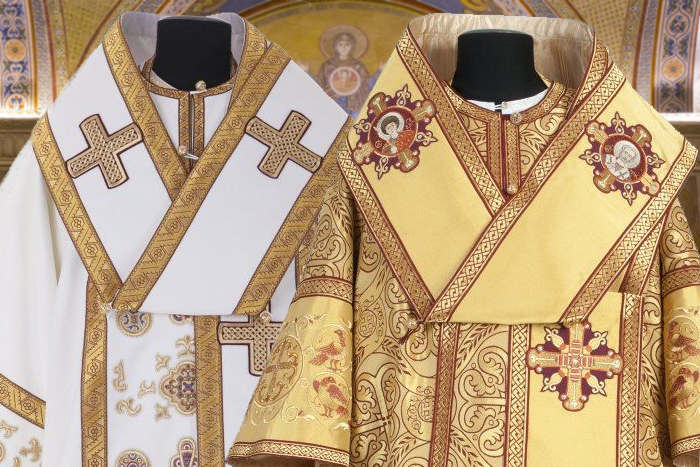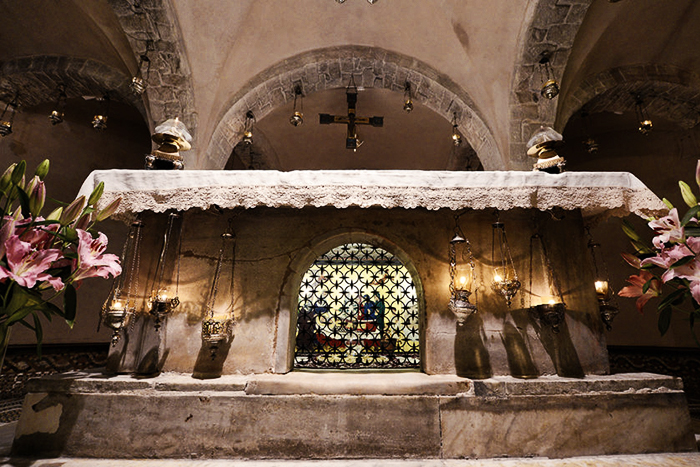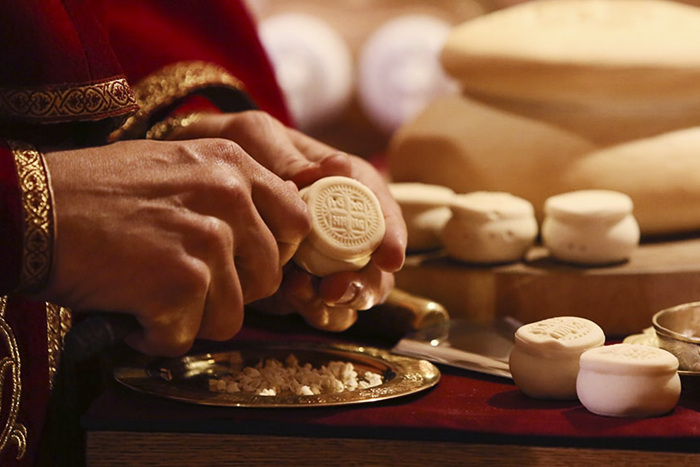
The omophorion is an integral part of the bishop’s liturgical vestment. It is by this liturgical vestment that believers recognize holy hierarchs on icons. What is the origin of this item of vestment, how is it used during worship, and what does it symbolize?
Origin
The omophorion (Greek: Ὠμοφόριον, from ὦμος – shoulder and φόρος – carrier) is a long, wide ribbon with the images of crosses, worn by a bishop on his shoulders so that one edge of the ribbon hangs from his back and the other from the front, and the omophorion curves on his chest in the shape of the letter V (the so-called big omophorion). This is one of the most important and ancient elements of bishop’s vestments, without which bishops may not perform their sacramental duties. The small omophorion hangs on the chest with both ends, which are either sewn together or buttoned together. The origin of the omophorion, like many other objects, remains controversial for researchers, but its traces can be found in the early centuries of Church history. According to one version, the precursor of the omophorion was the ancient Jewish ephod worn by the High Priest, a breast metal plate with 12 stones symbolizing the 12 tribes of Israel. It is speculated that the omophorion is derived from the mantle worn by the Apostle Peter. The third point of view argues that the omophorion is a complex form of the orarion, originating from a special cape scarf, which was worn by important Roman officials and close associates of the emperor.
Whichever point of view one may adhere to, all of these versions are related to the notion of higher power and special service. Omophoria were worn both in the East and West, where they were called pallium (Latin: woolen cloak). Curiously enough, not all bishops in Byzantium could wear them initially, but only the leaders of major dioceses. By the tenth century, however, they were worn by all bishops, thus emphasizing the ontological equality of all bishops. In the West, the more “hierarchical” tradition prevailed and only the Pope and metropolitans of historically important sees could wear them.
Symbolism
The omophorion was first mentioned by St. Isidore of Pelusium († 449) at the beginning of the 5th century, evidencing its liturgical use. The Holy Father writes that “the bishop’s omophorion, made of wool and not of linen, means the lost sheep, which the Lord took upon His shoulders when He found it. The bishop, as the image of Christ, carries out the work of Christ, and shows to all that he is like the good and great Shepherd, set to bear the weaknesses of the flock. (Letter 136, to Comitus Herminius). Along with the symbolism of the Good Shepherd, inspired by the Gospel parable (see Luke 15:4-7), the traditional interpretation of Omophorion is also the Christological dogma of the Incarnation of Logos, His union with the fallen human nature and the theosis of the latter. This is the view of St. Symeon of Thessalonica († 1429): “The omophorion means the Lord becoming human for our sake and the incarnation of the Logos from the Virgin. That is why it is made of wool, for it depicts the lost sheep, which was taken by the Savior onto His shoulders, that is, our nature, and that He came down from heaven, was incarnated and, being called the Lamb, was slain for us” (The Wisdom of Our Salvation). This image also dominated in the liturgical life, so the deacon recites the following prayer when the Bishop is being dressed in the omophorion, “O Christ, you have taken the lost sheep upon yourself, and when you ascended, you brought it unto God the Father, always, now and ever, and unto the ages of ages. Amen” (Bishop’s Chinovnik). The crosses on the omophorion indicate the readiness of the bishop to bear the burdens and the weaknesses of his flock, just as the Lord on the cross took “our griefs and carried our sorrows” (Isaiah 53:4). The two cross stripes at the bottom of the omophorion signify the cutting off of worldly lusts.
Use
Thanks to the “pictorial symbolism” that spread in the Church, it became common practice to take off and put on the omophorion several times during the Liturgy. The great omophorion is used at the beginning of the service; by the beginning of the Scripture reading it is taken off, and the bishop proceeds to serve in the small one. The practice of serving the Anaphora in the small omophorion led some historians to believe that it is more ancient than the great omophorion, but it is not. The point is that at a certain point in the Liturgy, the back end was shifted to the chest to represent the ancient priestly epitrachelion, but over time it was deemed inconvenient and so the small omophorion came to be. The small omophorion is put aside while reading the Gospel, which has been practiced since the time of St. Isidore (“When the true Shepherd himself comes at the opening of the Gospel, then the bishop rises up and puts down the image that likens him to Christ, thus indicating that it is the Lord, the Leader of all shepherds, God and the Ruler himself who is in charge” ( Ibid.)), during the transfer of bread and wine to the Holy Table and the sacramental change of the Holy Gifts. The omophorion is thus the main attribute of the bishop’s ministry, and a symbol of the presence of Christ the Shepherd of shepherds in the Church.



